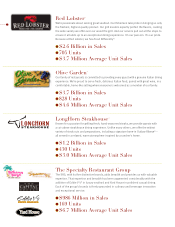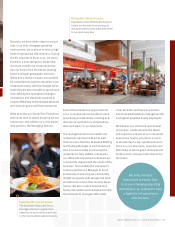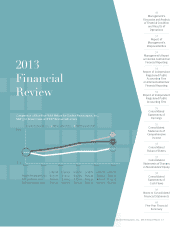Red Lobster 2013 Annual Report Download - page 11
Download and view the complete annual report
Please find page 11 of the 2013 Red Lobster annual report below. You can navigate through the pages in the report by either clicking on the pages listed below, or by using the keyword search tool below to find specific information within the annual report.
factors having nothing to do with life
stage that are weighing on employment
and income growth. Whatever the reason,
the result is a significant number of guests
who increasingly base their restaurant
choices on affordability.
At the same time, many other guests are
far from financially constrained. They have
changing tastes and preferences that
reflect rising household incomes and are
increasingly interested in higher-quality,
on-trend menu offerings and flexible
experiences that fit their schedules. In
addition, both sets of guests – the
financially constrained and the financially
comfortable – are increasingly multicultural
and multigenerational, developments that
are also driving meaningful changes in
tastes and preferences.
Given these dynamics, as we entered
fiscal 2013 there had been an approxi-
mate 2 percent a year decline in total
casual dining traffic between fiscal 2008,
when the most recent recession started,
and fiscal 2012. Importantly, major casual
dining chains had held up better than
casual dining overall, with cumulative
total traffic growth of 0.6 percent over this
period, fueled in part by a sharp increase
in price incentives. In addition, during
this period Darden achieved a significant
gain in market share, with our three large
brands experiencing cumulative total
traffic growth of 10.1 percent.
However, below the total traffic growth
level, a concerning development for major
chains and for us was the steady erosion
in same-restaurant traffic over this period.
Between fiscal 2008 and fiscal 2012, major
chains had an 18.2 percent decline in
same-restaurant traffic on a cumulative
basis. And, while our three large brands
did better, on a blended basis our same-
restaurant traffic declined 7.7 percent on
a cumulative basis.
Responding To The Dynamics
As fiscal 2013 began, we had already
made a number of changes to address the
con sumer realities behind the same-
restaurant traffic erosion the casual
dining industry and we were experiencing,
and we were planning additional steps.
To broaden our guest base, especially
with more affluent guests and Millenial
and Gen X guests, we had been adding to
our Specialty Restaurant Group – first
with the acquisition of Eddie V’s in fiscal
2012 and, more significantly, with the
acquisition of Yard House, which was in
the due diligence stage early in fiscal 2013
and completed at the very beginning of
the second quarter. In addition, each of
our three large casual dining brands had
affordability initiatives planned for fiscal
2013, with a focus on both our promo-
tional offers and core menus.
At the Darden level, we had launched
several initiatives to address consumer
interests beyond affordability that
continued during fiscal 2013. In fiscal
2012, for example, we developed a
multiyear plan to enhance our technology
capabilities so we will be able to engage
as fully as possible with guests as they
lead increasingly digital lifestyles, and
we planned to begin implementing the
first phase in fiscal 2013. We had also
established an enterprise Marketing
group to focus on developing more
extensive, multiyear initiatives to reshape
the guest experiences we offer, and
planned to begin implementing several
of these in fiscal 2013 as well. We also
recognized the need to reshape our
Marketing and Operations teams at each
brand so that we could be brilliant with
the basics today, while also moving faster
to make enduring changes to the guest
experiences we offer in the future. As a
result, coming into fiscal 2013 we were
rethinking how we should organize
our large brands’ Marketing and
Operations teams.
Accelerating Change In Fiscal 2013
As fiscal 2013 unfolded, it quickly
became clear that the degree and pace
of change we had planned for the year
was insufficient. In the fourth quarter of
fiscal 2012, for the first quarter since the
start of the recent recession in fiscal
2008, blended same-restaurant traffic at
our three large brands lagged the industry.
As we continued to have weaker than the
industry results on this important profit-
able sales growth driver in the first two
quarters of fiscal 2013, we moved with
added urgency on a number of fronts.
We began to match competitive promo-
tional intensity around affordability,
which involved being more aggressive
with the pricing of our offers, placing
greater emphasis on price in our advertising
messages and being more active in the
use of tactics such as daily and weekly
digital specials to support our offers.
We also stepped up the emphasis on
affordability in our core menus, which
included launching with heavy media
support of a new core menu at Red Lobster
that has a significant affordability
component and accelerating the
introduction of new, more affordably
priced core menu offerings at Olive Garden
and LongHorn Steakhouse.
Just as importantly, we increased the
resources dedicated to reshaping our
guest experiences to respond to what
guests want beyond affordability. Among
other things, this included moving forward
…both sets of guests –
the financially constrained and
the financially comfortable – are
increasingly multicultural and
multigenerational, developments
that are also driving meaningful
changes in tastes and
preferences.
Darden Restaurants, Inc. 2013 Annual Report 7

